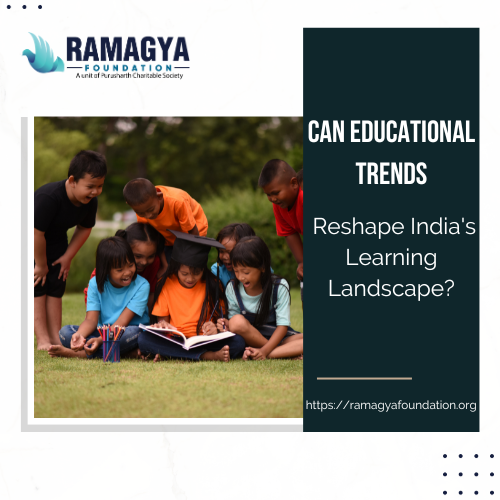
As a student, you can recall sitting in a classroom listening to teachers giving lectures and taking notes with a pen and paper. We raised our hands and waited for the teachers to respond if we had questions. The most high-tech tool in the room was a chalkboard.
“Embracing digital education isn’t just a choice, and it’s necessary to empower our students with the skills they need for the rapidly changing world ahead.”
In the not-so-distant past, classrooms were filled with the rhythmic sound of chalk against blackboards, the rustling of paper and textbooks, and the hushed murmurs of students engaged in traditional learning. But India’s education landscape, especially for underprivileged children, is undergoing a dramatic transformation with the arrival of 2023.
When the COVID-19 pandemic[1] struck, it forced many schools to adopt remote learning, making education technology-driven! Hence, making video conferencing and online learning platforms the norm to connect.
As we navigate this changing terrain, let’s explore five key education trends poised to reshape the learning experience for these children and bridge the gap between privilege and deprivation.
- From Chalkboards to Digital Dashboards: Rewind on your school days, and you might recall the simplicity of chalkboards and notebooks. But the modern classroom has embraced a digital metamorphosis. Underprivileged students, who might not have had access to high-tech tools before, are now experiencing a new learning dimension. With laptops or tablets in hand, they’re exploring interactive lessons, virtual reality experiences, and digital assignments that transcend the limitations of traditional textbooks.
- Tech-Powered Interactivity: In the dynamic education landscape 2023, interactivity is the game’s name. For underprivileged children, this means a departure from passive learning. Instead, they engage with virtual labs, simulations, and interactive whiteboards that bring subjects to life. This trend ensures that learning is not confined to the classroom walls but extends to the vibrant digital realm.
- The Rise of Remote Learning: The COVID-19 pandemic accelerated the adoption of remote learning. Suddenly, education transcended geographical barriers, allowing underprivileged children to access resources and knowledge like never before. Video conferencing and online platforms became the bridge between teachers and students. While the pandemic presented challenges, it also propelled innovation, making education a click away for those who lacked traditional access.
- Personalized Learning Journeys: Underprivileged children often grapple with diverse learning needs and varying paces of comprehension. Enter personalized learning, a trend that tailors education to individual requirements. Adaptive technologies, data analytics, and individualized lesson plans ensure no child is left behind. This empowers underprivileged students to grasp concepts at their own pace, fostering a deeper understanding of subjects.
- Skill-Centric Education: The traditional focus on rote learning gradually leads to skill-centric education. For underprivileged children, this shift is particularly empowering. They’re exposed to vocational training, digital literacy, and skill development that equips them for a dynamic job market. As they acquire practical skills, these children are polished to break the cycle of poverty and carve their path to success.
Why These Trends Matter for Underprivileged Children:
These education trends are not just buzzwords but critical drivers of change for underprivileged children. By embracing technology, personalization, and skill-based learning, we’re giving them tools to overcome socioeconomic barriers. These trends foster inclusivity, equipping them with the skills and knowledge required to thrive in an increasingly digital and competitive world.
Statistics to Delve:
- According to a UNICEF report, nearly 32 million Indian children aged 6 to 13 still do not attend school.
- Annual Status of Education Report (ASER) 2020 reveals that 25% of rural children between 14 and 18 must be enrolled in school.
The education trends 2023 are poised to revolutionize the learning journey for underprivileged children in India. These trends optimize digital integration, personalized learning, skill development and remote access, catalyzing change. They reshape the classroom and empower young minds to dream beyond their circumstances.
As we at Ramagya Foundation harness the power of education to bridge gaps and shatter barriers, we pave the way for a brighter future for every child, regardless of their background.
“Education is the most powerful weapon which you can use to change the world.” – Nelson Mandela